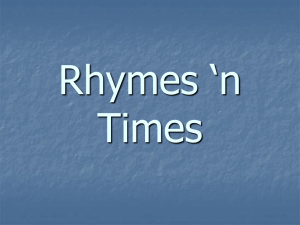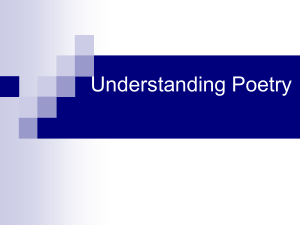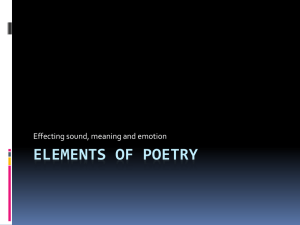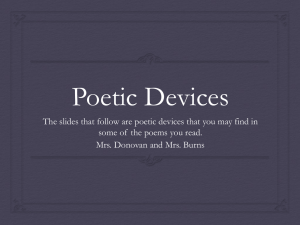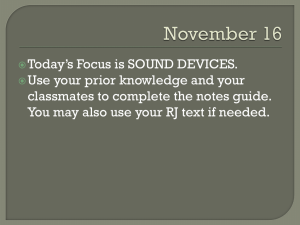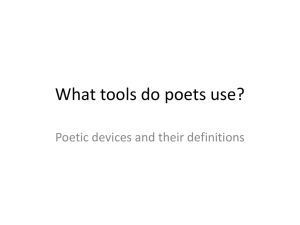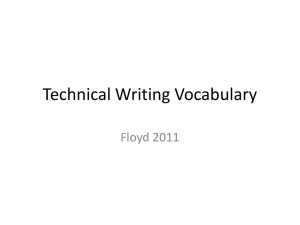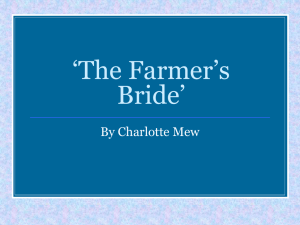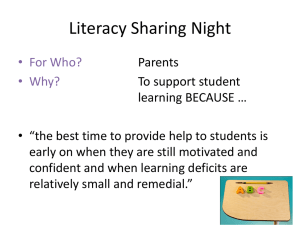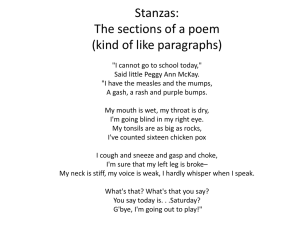Reading Handouts/Anchor Charts
advertisement
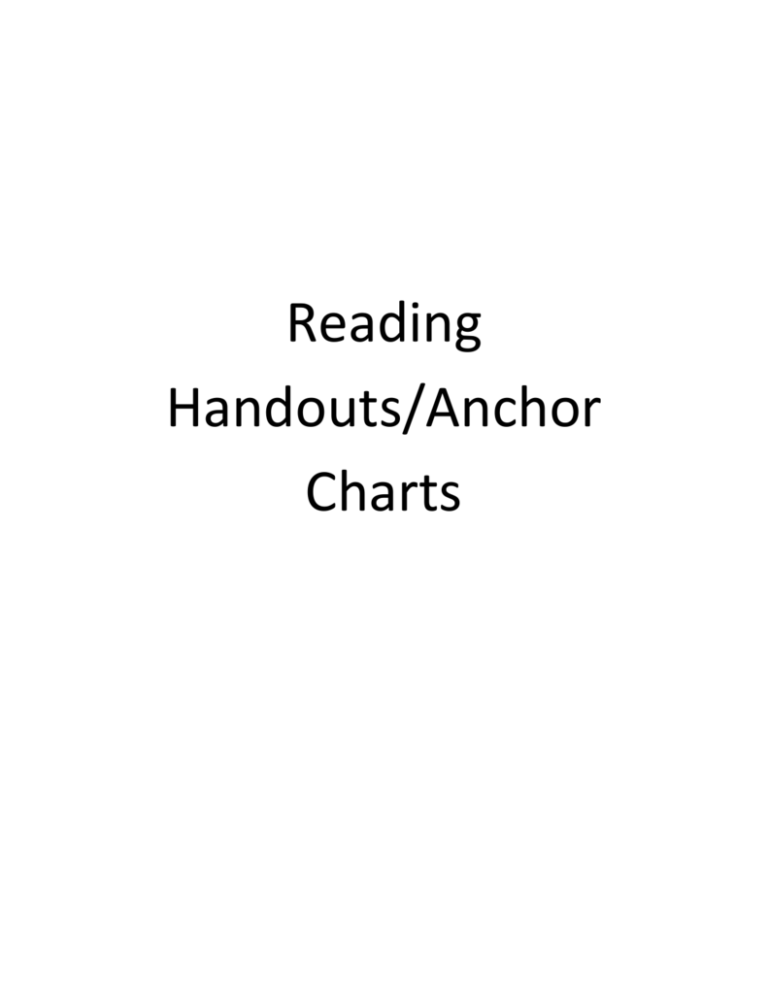
Reading Handouts/Anchor Charts Literary Nonfiction – A biography is the true story of a real person’s life, written by another person. An autobiography is the true story of a person’s life, written by that person. Noticings Author’s Purpose: to inform; to show why this person’s life is important Characters: the real person the biography is about is the subject; a biography tells what the subject accomplished and why he/she is important; other characters in the biography are real people who influenced the life of the subject in some way Setting: thinking about the time and place in which the subject lived will help readers understand more about the person Narrative Structure: events are told in order as a story; events may span the person’s entire life or may represent a specific time in the person’s life Point of View: -biography – 3rd person point of view -autobiography – 1st person point of view Book Examples Summarizing in Literary Nonfiction Summarizing an autobiography/biography is a retelling of the major events in a person’s life. Event 1 Summary: Event 2 Event 3 Event 4 Event 5 ***SAMPLE ANCHOR CHART FOR JAMES FORTEN!*** Summarizing in Literary Nonfiction Summarizing an autobiography/biography is a retelling of the major events in a person’s life. James was born in Philadelphia in 1766. He went to school and helped his father make sails in a shop. When James was 7, his father died. Event 1 Summary: In 1761, when James was 14, his mother gave him permission to go to sea. In the summer of 1781, James was on the Royal Louis. The Royal Louis engaged in battle with the British ship Active. Event 2 The Active surrendered. The Royal Louis then sailed into a trap. The crew of the Royal Louis became prisoners on a British Ship. Event 3 James befriended the British captain’s son. Then James was sent to a British prison ship instead of to the West Indies as a slave. James became a hero for fighting for freedom. After the war, he became of the wealthiest men in Philadelphia and one of the most influential abolitionists. Event 4 Event 5 James Forten, born in 1766, went to sea at the age of 14 to fight for America’s freedom from Britain and was taken prisoner by a British ship. He befriended the captain’s son and avoided being sold as a slave in the West Indies. After the war, he became wealthy and continued to fight for freedom, including becoming known as one of America’s most influential abolitionists. What it looks like on a Test… In paragraph __, the author symbolizes ___. In paragraph __, the author states that “__” to help the reader understand -Why does the author describe ___ as “__”? Read this sentence from paragraph __. What does the author mean by this line? What is the best summary of this selection? 5.7/Figure 19E ****Add these question stems to the bottom of your literary nonfiction charts**** Poetry – is a piece of writing in which words and their sounds are used to show images and express feelings and ideas. Noticings Author’s Purpose: to entertain or express Form: includes free verse, narrative, lyrical, and haiku Stanzas: the sections of a poem; a stanza may focus on one central idea or thought; lines in a stanza are arranged in a way that looks and sounds pleasing Rhyme: words that have the same ending sound may be used at the ends of lines to add interest to the poem and to make it fun to read Book Examples Author’s Purpose: to entertain the reader with a funny poem about a dirty man who never takes baths Form: lyrical Stanzas: Oh, I'm Dirty Dan, the world's dirtiest man, I never have taken a shower. I can't see my shirt--it's so covered with dirt, And my ears have enough to grow flowers. But the water is either a little too hot, Or else it's a little too cold. I'm musty and dusty and patchy and scratchy And mangy and covered with mold. But the water is always a little too hot, Or else it's a little too cold. Rhyme: Oh, I'm Dirty Dan, the world's dirtiest man, I never have taken a shower. I can't see my shirt--it's so covered with dirt, And my ears have enough to grow flowers. The Dirtiest Man In The World Oh, I'm Dirty Dan, the world's dirtiest man, I never have taken a shower. I can't see my shirt--it's so covered with dirt, And my ears have enough to grow flowers. But the water is either a little too hot, Or else it's a little too cold. I'm musty and dusty and patchy and scratchy And mangy and covered with mold. But the water is always a little too hot, Or else it's a little too cold. I live in a pen with five hogs and a hen And three squizzly lizards who creep in My bed, and they itch as I squirm, and I twitch In the cruddy old sheets that I sleep in. In you looked down my throat with a flashlight, you'd note That my insides are coated with rust. I creak when I walk and I squeak when I talk, And each time I sneeze I blow dust. The thought of a towel and soap makes me howl, And when people have something to tell me They don't come and tell it-they stand back and yell it. I think they're afraid they might smell me. The bedbugs that leap on me sing me to sleep, And the garbage flies buzz me awake. They're the best friends I've found and I fear they might drown So I never go too near a lake. Each evening at nine I sit down to dine With the termites who live in my chair, And I joke with the bats and have intimate chats With the cooties who crawl in my hair. I'd brighten my life if I just found a wife, But I fear that will never be Until I can find a girl, gentle and kind, With a beautiful face and a sensitive mind, Who sparkles and twinkles and glistens and shines-And who's almost as dirty as me. -Shel Silverstein Poetry Elements Sound Effect Rhyme Scheme Internal Alliteration Onomatopoeia Rhyme the pattern of rhyme that the poet uses occurs when poets use rhyming words within the same line Definition I love noodles. Give me oodles. A Make a mound up to the sun. B Noodles are my favorite foodles. A I eat noodles by the ton. B Example Let me fetch sticks, Let me fetch stones, Throw me your bones, Teach me your tricks. A B B A I live in a pen with 5 hogs and a hen And three squizzly lizards who creep in My bed, and they itch as I squirm, and I twitch In the cruddy old sheets I sleep in. the repetition of the first consonant sound in words, as in the nursery rhyme “Peter Piper picked a peck of pickled peppers.” I jiggled it jaggled it jerked it. I pushed and pulled and poked it. words that represent the actual sound of something are words of onomatopoeia. Thunder “booms,” rain “drips,” and the clock “ticks.”Appeals to the sense of sound. Scrunch, scrunch, scrunch. Crunch, crunch, crunch. Frozen snow and brittle ice Make a winter sound that’s nice Underneath my stamping feet And the cars along the street. Scrunch, scrunch, scrunch. Crunch, crunch, crunch. Poetry – is a piece of writing in which words and their sounds are used to show images and express feelings and ideas. Noticings Rhythm: the beat of how the words are read; Add these to anchor chart on Friday may be fast or slow Sound Effects: Repetition: occurs when poets repeat words, phrases, or lines in a poem Internal Rhyme: occurs when poets use rhyming words within the same line Rhyme Scheme the pattern of rhyme that the poet uses Alliteration the repetition of the first consonant sound in words, as in the nursery rhyme “Peter Piper picked a peck of pickled peppers.” Book Examples Rhythm: The pickety fence The pickety fence Give it a lick it's The pickety fence Give it a lick it's A clickety fence When the night begins to fall And the sky begins to glow You look up and see the tall City of lights begin to grow – Repetition Someone tossed a pancake, A buttery, buttery, pancake. Someone tossed a pancake And flipped it up so high, That now I see the pancake, The buttery, buttery pancake, Now I see that pancake Stuck against the sky. actual sound of something are words of onomatopoeia. Thunder “booms,” rain “drips,” and the clock “ticks.”Appeals to the sense of sound. Imagery & Sensory Detail the use of Add on Monday Figurative Language tools that writers use to create images, or “paint pictures,” in your mind. Simile compares two things using the words “like” or “as.” Metaphors compare two things without using the words “like” or “as.” Personification gives human traits and feelings to things that are not human – like animals or objects. The rhythm in this poem is slow – to match the night gently falling and the lights slowly coming on. Sound Effects: Onomatopoeia words that represent the words to create pictures, or images, in your mind. Appeals to the five senses: smell, sight, hearing, taste and touch. The rhythm in this poem is fast – to match the speed of the stick striking the fence. Internal Rhyme Rhyme Scheme Alliteration Onomatopoeia Imagery & Sensory Detail: Figurative Language: Simile Metaphors Personification see specific anchor charts for examples

